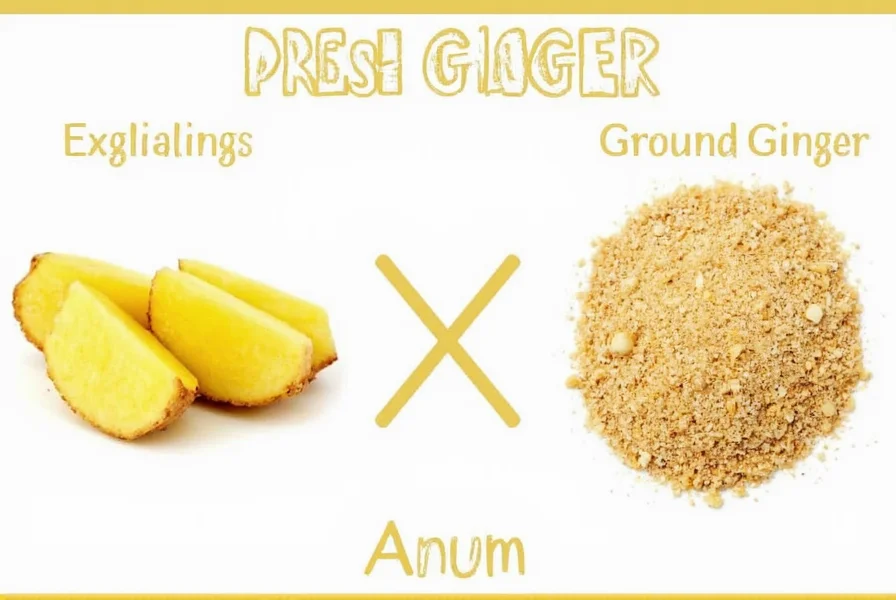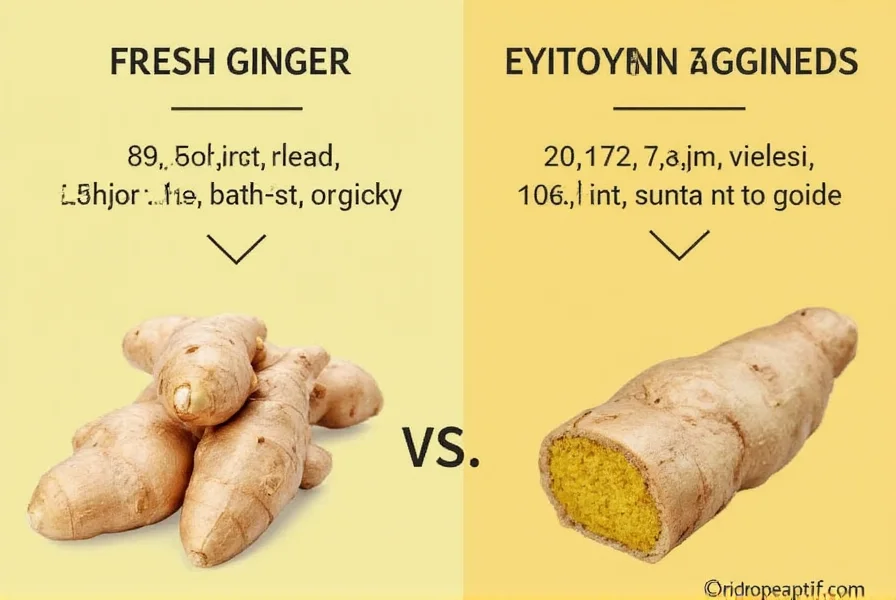When substituting fresh ginger for ground ginger in recipes, use a 3:1 ratio—3 parts fresh grated ginger equals 1 part ground ginger. For example, 1 tablespoon fresh ginger replaces 1 teaspoon ground ginger. Fresh ginger offers brighter, more complex flavor with citrus notes, while ground ginger provides warmer, more concentrated spice. This conversion works for most savory dishes, but requires adjustments in baking due to moisture differences.
Understanding how to properly substitute fresh ginger for ground ginger can transform your cooking results. Many home chefs find themselves reaching for the spice cabinet only to discover they've run out of ground ginger—or perhaps they prefer the vibrant flavor of fresh. Knowing the precise conversion and flavor implications ensures your recipes maintain their intended taste profile.
Understanding Ginger Forms and Their Properties
Fresh ginger root (Zingiber officinale) and ground ginger differ significantly in composition. Fresh ginger contains approximately 70% water, giving it a bright, zesty flavor with citrus undertones and subtle heat. Ground ginger, having lost moisture during processing, concentrates the warming, earthy compounds like gingerol and shogaol, resulting in a more intense but less complex flavor profile.
When considering how to substitute fresh ginger for ground ginger effectively, remember that dehydration concentrates flavor compounds. This concentration explains why the conversion isn't equal. The standard culinary ratio—3 parts fresh to 1 part ground—accounts for this concentration difference while maintaining recipe balance.

Precise Conversion Guidelines for Different Applications
The basic 3:1 ratio serves as your starting point, but specific applications require nuanced adjustments:
| Recipe Type | Ground Ginger Amount | Fresh Ginger Equivalent | Special Considerations |
|---|---|---|---|
| Savory dishes (stir-fries, curries) | 1 tsp | 1 tbsp freshly grated | Add fresh ginger earlier in cooking to mellow sharpness |
| Baking (cookies, cakes) | 1 tsp | 2 tsp freshly grated | Reduce other liquids by 1 tsp to compensate for moisture |
| Marinades & sauces | 1 tsp | 1.5 tbsp freshly grated | Strain if texture is undesirable |
| Teas & beverages | 1/4 tsp | 1-inch knob, sliced | Simmer 10-15 minutes for full extraction |
Flavor Profile Differences and Recipe Impact
When exploring fresh ginger to ground ginger conversion, consider how flavor differences affect your final dish. Fresh ginger delivers brighter, more complex notes with citrus undertones and sharper heat that mellows with cooking. Ground ginger offers warmer, more concentrated spice with earthier tones but lacks the nuanced complexity of fresh.
In delicate dishes like seafood or light sauces, fresh ginger's brightness enhances without overwhelming. For hearty winter recipes like gingerbread or chai, ground ginger's concentrated warmth often provides better balance. When substituting in baking, remember that fresh ginger adds moisture which can affect texture—reduce other liquids slightly when making the switch.
When Substitutions Work Best (and When They Don't)
Certain applications handle ginger substitution ratio in recipes better than others:
Ideal for substitution:
- Stir-fries and sautéed vegetable dishes
- Curry bases and simmered sauces
- Marinades for meats and tofu
- Smoothies and fresh juices
- Some quick breads (with moisture adjustment)
Limited success:
- Traditional gingerbread (ground ginger's concentrated flavor is essential)
- Dry spice rubs (fresh ginger adds unwanted moisture)
- Long-cooked stews (fresh ginger can become bitter)
- Commercial baking applications
Practical Tips for Successful Substitution
Follow these professional techniques when implementing your fresh ginger equivalent to ground ginger conversion:
- Grate properly: Use a microplane for fine shreds that distribute evenly without fibrous chunks
- Adjust timing: Add fresh ginger later in cooking than ground to preserve delicate flavors
- Balance acidity: Fresh ginger's brightness may require slight reduction in other acidic ingredients
- Consider texture: In sauces where texture matters, strain after cooking
- Taste and adjust: Always taste before final seasoning—fresh ginger's flavor develops differently

Storing Fresh Ginger for Future Use
When you make the switch to fresh ginger, proper storage extends its usability. Store unpeeled ginger root in a paper bag in the vegetable crisper for 2-3 weeks. For longer storage, peel and freeze whole pieces—frozen ginger grates beautifully without thawing. You can also store peeled ginger in vodka or sherry in the refrigerator for up to 6 months, which preserves flavor while mellowing sharpness.
Understanding these storage methods ensures you always have fresh ginger available when you need to substitute for ground ginger, eliminating last-minute recipe adjustments. This knowledge supports consistent results when implementing your ginger substitution ratio in recipes.
Common Questions About Ginger Substitution
Can I substitute ground ginger for fresh ginger using the same ratio?
No, the ratio works in reverse. When substituting ground for fresh, use 1/4 teaspoon ground ginger for every tablespoon of fresh ginger. Ground ginger is more concentrated, so using equal amounts would create an overpowering, bitter flavor in your dish.
Why does fresh ginger taste different from ground ginger in my recipes?
Fresh ginger contains volatile compounds that evaporate during drying and grinding. This changes the flavor profile significantly—fresh offers bright, citrusy notes with sharper heat, while ground provides warmer, more concentrated spice. The conversion ratio accounts for potency differences but cannot replicate the nuanced flavor variations.
How do I adjust recipes when substituting fresh ginger in baking?
When using fresh ginger instead of ground in baking, reduce other liquids by 1 teaspoon for every tablespoon of fresh ginger added. The moisture content in fresh ginger can affect texture. Also, consider increasing the amount slightly (use 2 teaspoons fresh per 1 teaspoon ground) since baking mutes fresh ginger's flavor more than ground.
Does the age of fresh ginger affect substitution ratios?
Yes, older ginger develops a stronger, more fibrous texture and concentrated flavor. For ginger older than 3 weeks, use 2.5 parts fresh to 1 part ground instead of the standard 3:1 ratio. Very young,嫩 ginger (spring ginger) may require a 3.5:1 ratio as its flavor is more delicate.
Can I make my own ground ginger from fresh?
Yes, but it requires proper technique. Peel and thinly slice fresh ginger, then dehydrate at 140°F (60°C) until brittle (8-12 hours). Grind to powder in a spice grinder, then sift. Store in an airtight container away from light. Homemade ground ginger has superior flavor to store-bought but loses potency faster—use within 2 months for best results.










 浙公网安备
33010002000092号
浙公网安备
33010002000092号 浙B2-20120091-4
浙B2-20120091-4